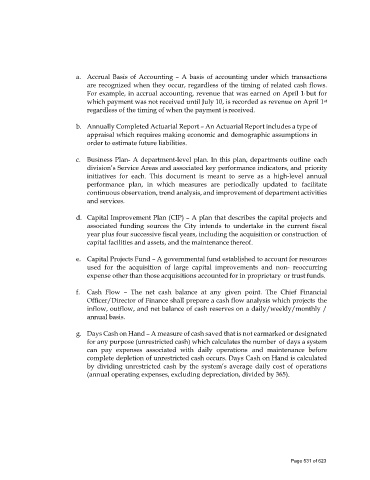Page 531 - FortWorthFY23AdoptedBudget
P. 531
a. Accrual Basis of Accounting – A basis of accounting under which transactions
are recognized when they occur, regardless of the timing of related cash flows.
For example, in accrual accounting, revenue that was earned on April 1 but for
,
which payment was not received until July 10, is recorded as revenue on April 1 st
regardless of the timing of when the payment is received.
b. Annually Completed Actuarial Report – An Actuarial Report includes a type of
appraisal which requires making economic and demographic assumptions in
order to estimate future liabilities.
c. Business Plan- A department-level plan. In this plan, departments outline each
division’s Service Areas and associated key performance indicators, and priority
initiatives for each. This document is meant to serve as a high-level annual
performance plan, in which measures are periodically updated to facilitate
continuous observation, trend analysis, and improvement of department activities
and services.
d. Capital Improvement Plan (CIP) – A plan that describes the capital projects and
associated funding sources the City intends to undertake in the current fiscal
year plus four successive fiscal years, including the acquisition or construction of
capital facilities and assets, and the maintenance thereof.
e. Capital Projects Fund – A governmental fund established to account for resources
used for the acquisition of large capital improvements and non- reoccurring
expense other than those acquisitions accounted for in proprietary or trust funds.
f. Cash Flow – The net cash balance at any given point. The Chief Financial
Officer/Director of Finance shall prepare a cash flow analysis which projects the
inflow, outflow, and net balance of cash reserves on a daily/weekly/monthly /
annual basis.
g. Days Cash on Hand – A measure of cash saved that is not earmarked or designated
for any purpose (unrestricted cash) which calculates the number of days a system
can pay expenses associated with daily operations and maintenance before
complete depletion of unrestricted cash occurs. Days Cash on Hand is calculated
by dividing unrestricted cash by the system’s average daily cost of operations
(annual operating expenses, excluding depreciation, divided by 365).
Page 531 of 623

